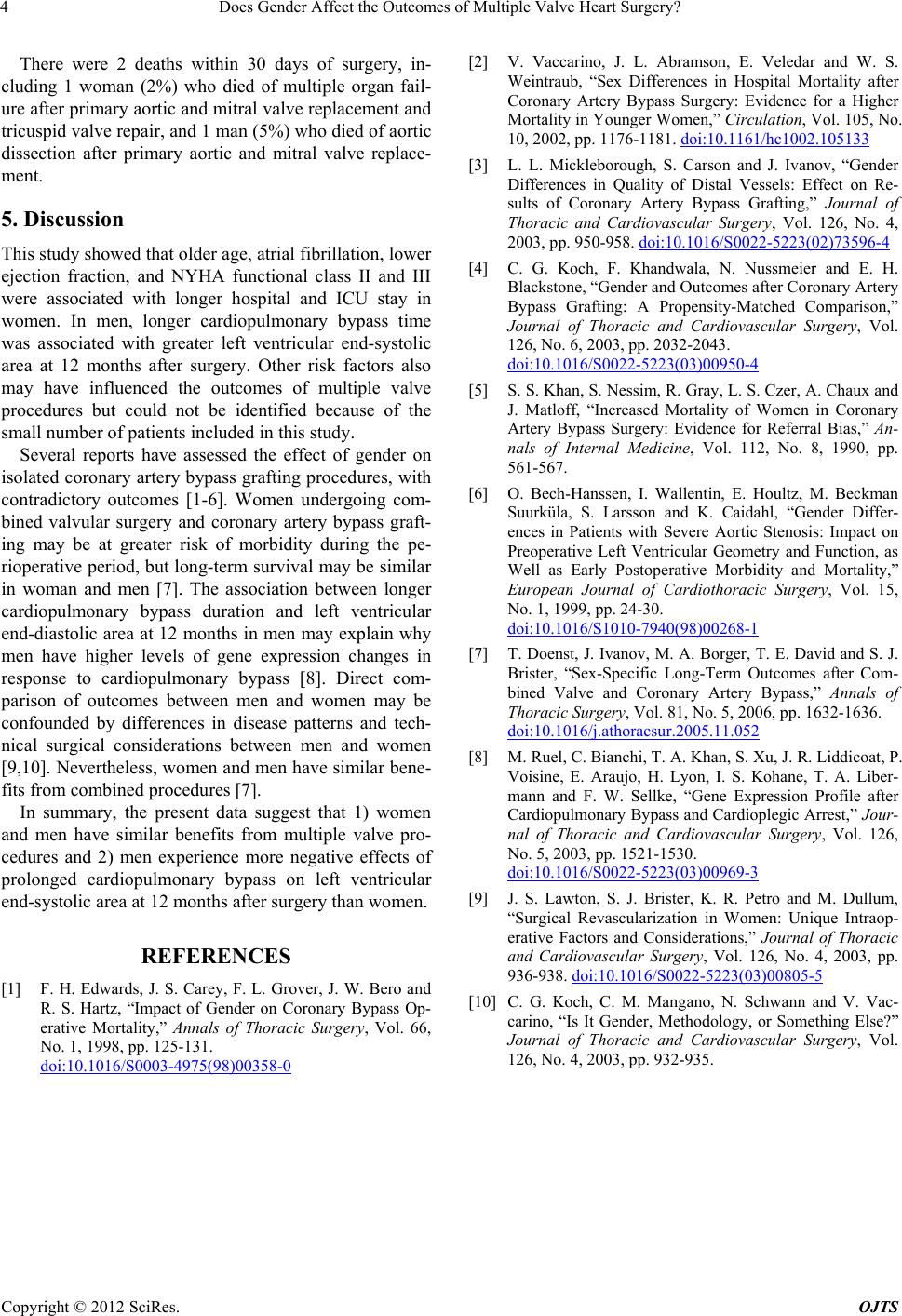
Does Gender Affect the Outcomes of Multiple Valve Heart Surgery?
Copyright © 2012 SciRes. OJTS
4
There were 2 deaths within 30 days of surgery, in-
cluding 1 woman (2%) who died of multiple organ fail-
ure after primary aortic and mitral valve replacement and
tricuspid valve repair, and 1 man (5%) who died of aortic
dissection after primary aortic and mitral valve replace-
ment.
5. Discussion
This study showed that older age, atrial fibrillation, lower
ejection fraction, and NYHA functional class II and III
were associated with longer hospital and ICU stay in
women. In men, longer cardiopulmonary bypass time
was associated with greater left ventricular end-systolic
area at 12 months after surgery. Other risk factors also
may have influenced the outcomes of multiple valve
procedures but could not be identified because of the
small number of patients included in this study.
Several reports have assessed the effect of gender on
isolated coronary artery bypass grafting procedures, with
contradictory outcomes [1-6]. Women undergoing com-
bined valvular surgery and coronary artery bypass graft-
ing may be at greater risk of morbidity during the pe-
rioperative period, but long-term survival may be similar
in woman and men [7]. The association between longer
cardiopulmonary bypass duration and left ventricular
end-diastolic area at 12 months in men may explain why
men have higher levels of gene expression changes in
response to cardiopulmonary bypass [8]. Direct com-
parison of outcomes between men and women may be
confounded by differences in disease patterns and tech-
nical surgical considerations between men and women
[9,10]. Nevertheless, women and men have similar bene-
fits from combined procedures [7].
In summary, the present data suggest that 1) women
and men have similar benefits from multiple valve pro-
cedures and 2) men experience more negative effects of
prolonged cardiopulmonary bypass on left ventricular
end-systolic area at 12 months after surgery than women.
REFERENCES
[1] F. H. Edwards, J. S. Carey, F. L. Grover, J. W. Bero and
R. S. Hartz, “Impact of Gender on Coronary Bypass Op-
erative Mortality,” Annals of Thoracic Surgery, Vol. 66,
No. 1, 1998, pp. 125-131.
doi:10.1016/S0003-4975(98)00358-0
[2] V. Vaccarino, J. L. Abramson, E. Veledar and W. S.
Weintraub, “Sex Differences in Hospital Mortality after
Coronary Artery Bypass Surgery: Evidence for a Higher
Mortality in Younger Women,” Circulation, Vol. 105, No.
10, 2002, pp. 1176-1181. doi:10.1161/hc1002.105133
[3] L. L. Mickleborough, S. Carson and J. Ivanov, “Gender
Differences in Quality of Distal Vessels: Effect on Re-
sults of Coronary Artery Bypass Grafting,” Journal of
Thoracic and Cardiovascular Surgery, Vol. 126, No. 4,
2003, pp. 950-958. doi:10.1016/S0022-5223(02)73596-4
[4] C. G. Koch, F. Khandwala, N. Nussmeier and E. H.
Blackstone, “Gender and Outcomes after Coronary Artery
Bypass Grafting: A Propensity-Matched Comparison,”
Journal of Thoracic and Cardiovascular Surgery, Vol.
126, No. 6, 2003, pp. 2032-2043.
doi:10.1016/S0022-5223(03)00950-4
[5] S. S. Khan, S. Nessim, R. Gray, L. S. Czer, A. Chaux and
J. Matloff, “Increased Mortality of Women in Coronary
Artery Bypass Surgery: Evidence for Referral Bias,” An-
nals of Internal Medicine, Vol. 112, No. 8, 1990, pp.
561-567.
[6] O. Bech-Hanssen, I. Wallentin, E. Houltz, M. Beckman
Suurküla, S. Larsson and K. Caidahl, “Gender Differ-
ences in Patients with Severe Aortic Stenosis: Impact on
Preoperative Left Ventricular Geometry and Function, as
Well as Early Postoperative Morbidity and Mortality,”
European Journal of Cardiothoracic Surgery, Vol. 15,
No. 1, 1999, pp. 24-30.
doi:10.1016/S1010-7940(98)00268-1
[7] T. Doenst, J. Ivanov, M. A. Borger, T. E. David and S. J.
Brister, “Sex-Specific Long-Term Outcomes after Com-
bined Valve and Coronary Artery Bypass,” Annals of
Thoracic Surgery, Vol. 81, No. 5, 2006, pp. 1632-1636.
doi:10.1016/j.athoracsur.2005.11.052
[8] M. Ruel, C. Bianchi, T. A. Khan, S. Xu, J. R. Liddicoat, P.
Voisine, E. Araujo, H. Lyon, I. S. Kohane, T. A. Liber-
mann and F. W. Sellke, “Gene Expression Profile after
Cardiopulmonary Bypass and Cardioplegic Arrest,” Jour-
nal of Thoracic and Cardiovascular Surgery, Vol. 126,
No. 5, 2003, pp. 1521-1530.
doi:10.1016/S0022-5223(03)00969-3
[9] J. S. Lawton, S. J. Brister, K. R. Petro and M. Dullum,
“Surgical Revascularization in Women: Unique Intraop-
erative Factors and Considerations,” Journal of Thoracic
and Cardiovascular Surgery, Vol. 126, No. 4, 2003, pp.
936-938. doi:10.1016/S0022-5223(03)00805-5
[10] C. G. Koch, C. M. Mangano, N. Schwann and V. Vac-
carino, “Is It Gender, Methodology, or Something Else?”
Journal of Thoracic and Cardiovascular Surgery, Vol.
126, No. 4, 2003, pp. 932-935.